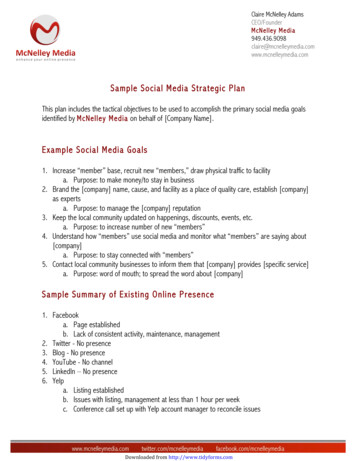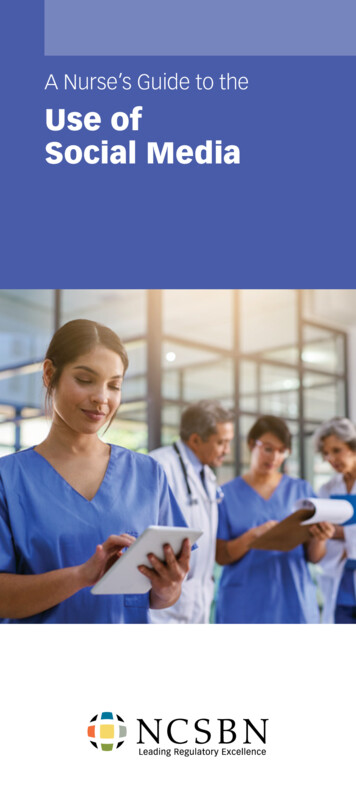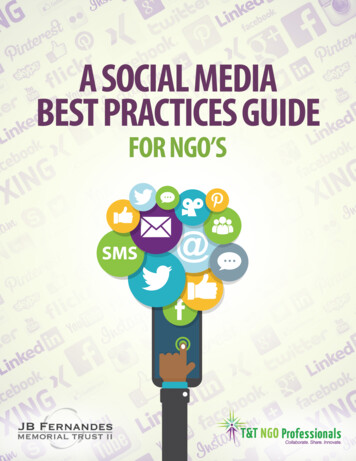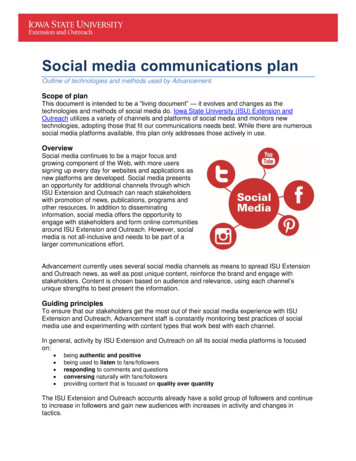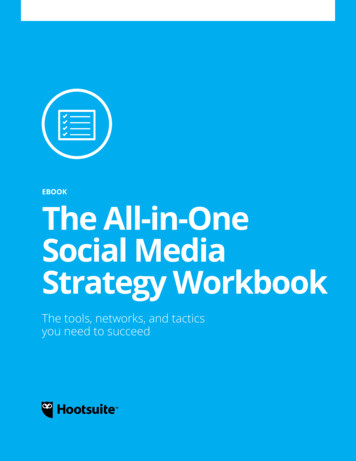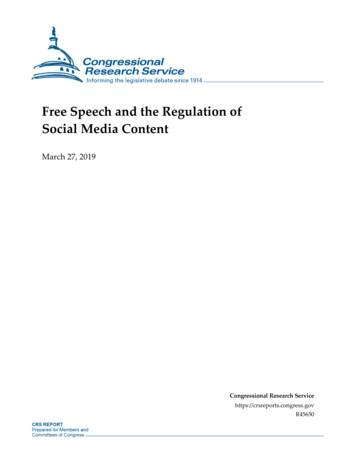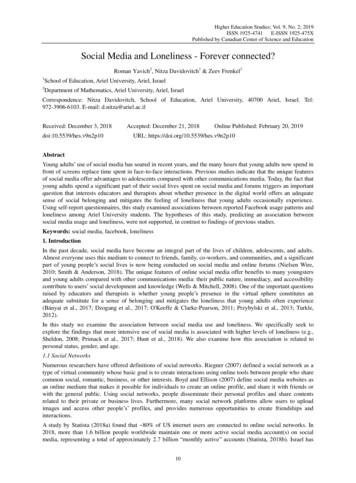
Transcription
Higher Education Studies; Vol. 9, No. 2; 2019ISSN 1925-4741E-ISSN 1925-475XPublished by Canadian Center of Science and EducationSocial Media and Loneliness - Forever connected?Roman Yavich2, Nitza Davidovitch1 & Zeev Frenkel21School of Education, Ariel University, Ariel, Israel2Department of Mathematics, Ariel University, Ariel, IsraelCorrespondence: Nitza Davidovitch, School of Education, Ariel University, 40700 Ariel, Israel. Tel:972-3906-6103. E-mail: d.nitza@ariel.ac.ilReceived: December 3, 2018doi:10.5539/hes.v9n2p10Accepted: December 21, 2018Online Published: February 20, 2019URL: https://doi.org/10.5539/hes.v9n2p10AbstractYoung adults‘ use of social media has soared in recent years, and the many hours that young adults now spend infront of screens replace time spent in face-to-face interactions. Previous studies indicate that the unique featuresof social media offer advantages to adolescents compared with other communications media. Today, the fact thatyoung adults spend a significant part of their social lives spent on social media and forums triggers an importantquestion that interests educators and therapists about whether presence in the digital world offers an adequatesense of social belonging and mitigates the feeling of loneliness that young adults occasionally experience.Using self-report questionnaires, this study examined associations between reported Facebook usage patterns andloneliness among Ariel University students. The hypotheses of this study, predicting an association betweensocial media usage and loneliness, were not supported, in contrast to findings of previous studies.Keywords: social media, facebook, loneliness1. IntroductionIn the past decade, social media have become an integral part of the lives of children, adolescents, and adults.Almost everyone uses this medium to connect to friends, family, co-workers, and communities, and a significantpart of young people‘s social lives is now being conducted on social media and online forums (Nielsen Wire,2010; Smith & Anderson, 2018). The unique features of online social media offer benefits to many youngstersand young adults compared with other communications media: their public nature, immediacy, and accessibilitycontribute to users‘ social development and knowledge (Wells & Mitchell, 2008). One of the important questionsraised by educators and therapists is whether young people‘s presence in the virtual sphere constitutes anadequate substitute for a sense of belonging and mitigates the loneliness that young adults often experience(Bányai et al., 2017; Dzogang et al., 2017; O'Keeffe & Clarke-Pearson, 2011; Przybylski et al., 2013; Turkle,2012).In this study we examine the association between social media use and loneliness. We specifically seek toexplore the findings that more intensive use of social media is associated with higher levels of loneliness (e.g.,Sheldon, 2008; Primack et al., 2017; Hunt et al., 2018). We also examine how this association is related topersonal status, gender, and age.1.1 Social NetworksNumerous researchers have offered definitions of social networks. Riegner (2007) defined a social network as atype of virtual community whose basic goal is to create interactions using online tools between people who sharecommon social, romantic, business, or other interests. Boyd and Ellison (2007) define social media websites asan online medium that makes it possible for individuals to create an online profile, and share it with friends orwith the general public. Using social networks, people disseminate their personal profiles and share contentsrelated to their private or business lives. Furthermore, many social network platforms allow users to uploadimages and access other people‘s‘ profiles, and provides numerous opportunities to create friendships andinteractions.A study by Statista (2018a) found that 80% of US internet users are connected to online social networks. In2018, more than 1.6 billion people worldwide maintain one or more active social media account(s) on socialmedia, representing a total of approximately 2.7 billion ―monthly active‖ accounts (Statista, 2018b). Israel has10
http://hes.ccsenet.orgHigher Education StudiesVol. 9, No. 2; 2019one of the highest Internet and social media use rates in the world (Poushter, Bishop, & Chwe, 2018). Accordingto this research, most of Israel‘s adults use the Internet (88%) and social media (68%), compared to worldwidemedians are 75% and 53%, respectively. However, such results are inconsistent with the total number of activesocial media accounts in Israel (Statista, 2018b), suggesting that the estimation that only 58% of Israel adults usesocial media (Statista, 2017a) is more realistic. Social media users spend an average of 2 hours and 22 minutesdaily on social media (3 hours for people between age 16 and 25; Bayindir & Kavanagh, 2018).Social networks provide numerous opportunities to share content, converse with others, design a private andpublic identity, develop and cultivate relationships, develop a reputation, create interactions with like-mindedothers, and identify available community resources. Social networks make it possible to locate and connect toacquaintances from the past, and quickly remain abreast of events, schedule and document events, create interestgroups, disseminate important information, perform marketing activities, and generate social interest (Bayindir& Kavanagh, 2018; Boniel-Nissim, 2010). This communication medium, characterized mainly by interactionswith acquaintances, is so common that it constitutes an important tool in managing and maintaining friendships(Bayindir & Kavanagh, 2018; Steinfield et al., 2012). The features of social network website use includeanonymity and an absence of face-to-face contact. Anonymity online makes it possible to create free egalitariangatherings that could not necessarily exist in the real world due to differences of religion, age, race, gender,geographic location, and other factors (Boniel-Nissim, 2010). Nonetheless it appears that the type of onlineanonymity that characterizes social media networks does not necessary protect privacy as it contains identifyingimages that often disclose more than do face-to-face interactions (Barak, 2006).Much research has extensively studied the association between Internet use and psychological well-being, andfound that intensive Internet use leads to a decline in interactions among family members. The findings of theHomeNet Project (Kraut et al., 1998) indicate that participants who spend a significant share of their time onlinereported high levels of loneliness and stress during the day. Another study found that intensive Internet surfingwas associated with a high risk of depression (Kraut et al., 2002). Researchers also found that loneliness anddepression are associated with risky online behaviors (Ceyhan & Ceyhan, 2008) and regular social media usage(Hunt et al., 2018).Studies show that online social activity leads to changes in modern attachment patterns in human society,especially in adolescents and young adults (Chukwuere & Chukwuere, 2017; Kontos et al., 2010; Prensky, 2001).The lack of eye contact, which is a prominent feature of the resulting social interactions, leads to highself-disclosure, as textual communications devoid of eye contact invite direct and relaxed conversations (Mesch& Talmud, 2010). Despite the numerous advantages of self-disclosure, which contributes to emotionalventilation, reflection, and alleviates emotional conditions (Hawi & Samaha, 2017; Leung, 2002; Moody, 2001;Smyth, True & Souto, 2001), public exposure may also invite bullying and harassment (Chukwuere &Chukwuere, 2017; Fuchs, 2017; Hinduja & Patchin, 2008). It is also should be noted that virtual friendship isquite different from traditional face-to-face friendship. Preference of virtual friendship leads to a decline in socialskills (Bonebrake, 2002; Fuchs, 2017; Kraut et al., 1998).Another direction of research on Internet use found that individual personality traits affect online surfingoutcomes. Introverts experience a decline in community-based activities and an increase in loneliness, whileextroverts experience an increase in community-based activities and a decline in loneliness (Kraut et al., 2002).Need for belonging and need for self-representation are two basic social needs that drive social media use.1.2 Facebook as a Social NetworkWhile social networks offer a large number of platforms, led by Facebook, YouTube, WhatsApp, WeChat, andothers, Facebook is the dominant social network worldwide (Statista, 2018a), and in Israel, with over 3.7 millionusers in Israel (43% of adults, Statista, 2017b). Facebook was found to be a factor in connecting friends (ratherthan make new contacts; Ellison, Steinfield, & Lampe, 2007, Bayindir & Kavanagh, 2018), a major element inreinforcing social ties and maintaining existing ties, and a means of access to friends‘ information and emotions.Facebook usage patterns are related to unrestrained conduct and an absence of worries about social evaluation(Joinson, 2007). Facebook created a social-behavioral revolution and a revolution in university students‘ socialskills (Hawi & Samaha, 2017; Sheldon, 2008). Facebook is used by students for various purposes, includingmaintaining contact with classmates and other members of the department, dormitory residents, and otherstudents (Bayindir & Kavanagh, 2018; Sheldon, 2008). Facebook is also considered ―social glue‖ that helpsstudents adjust to university life (Madge et al., 2009). Some students create profiles that include elements such aspolitical opinions and religious beliefs (Pempek, Yermolayeva, & Calvert, 2009). Studies indicate that studentshave only several dozens of friends with whom they maintain contact outside the social networks (Ellison,11
http://hes.ccsenet.orgHigher Education StudiesVol. 9, No. 2; 2019Steinfield & Lampe, 2007), while the mean number of friends in Facebook is about 300-400.Studies found that personality traits affect a person‘s ability to accumulate friends on Facebook. For example,people with social anxiety tend to use Facebook more intensively but report fewer friends, compared toextroverts who tend to use Facebook more moderately yet report having more friends (Sheldon, 2008). Anotherstudy that also examined personality effects found that shy people express a high degree of affinity for Facebookyet accumulate fewer friends (Orr et al., 2009). Studies on psychological well-being found that students with lowself-esteem and low life satisfaction use Facebook to increase their social capital. Although Facebook has beenfound to satisfy social needs, it does not as yet satisfy the emotional needs that face-to-face interactions offer(Ellison, Steinfield, & Lampe, 2007; Hawi & Samaha, 2017).1.3 Social SupportThe literature defines social support as a resource provided by others that has a direct or indirect effect on therecipient‘s behavior and quality of life (Antle, Montgomery, & Stapleford, 2009). Social ties with one‘senvironment are a basic, innate biological need and satisfy numerous individual needs, including the need foreducation, a secure income, health and concern. Social ties provide a network of individuals and groups thatoffer encouragement, empathy, and models of behavior and social identity (Barker, 1999). Consequently, socialties are a source of support for individuals, and contribute to their quality of life and physical and psychologicalwell-being. A person‘s network of social ties constitutes a measure of their social efficacy, participation in society,and at the same time constitutes their social support system (King et al., 2006). Social support is amulti-dimensional concept that concerns social and interpersonal relations, and involves various types of formaland ties, processes (Barker, 1999; Gottlieb & Bergen, 2010; Ryff & Singer, 2000), and resources, includingmonetary and physical resources, information resources, emotional resources, and social belonging (Oxman &Hull, 1997).Social support is an environmental and interpersonal variable that constitutes an external coping resource for theindividual and satisfies the individual‘s needs for appreciation, affection, and a feeling of security and belonging.These needs are satisfied through significant others with whom the individual maintains relationships. In the pastdecade, the virtual sphere — social networks and especially Facebook — has extended the physical space ofsocial ties. The virtual sphere has made us much more ―connected.‖1.4 Loneliness and Social NetworksMany researchers have addressed the definition of loneliness. The common definition of loneliness is thedifference between a person‘s desire for social relationships and her actual social relationships (Russell et al.,1980). It is important to distinguish between social isolation and loneliness. Social isolation refers to theobjective number of relationships in which one is involved, while loneliness reflects one‘s self-perceived socialisolation (Masi et al., 2011). Feeling of loneliness is subjective, and it is the interpretation that an individualgives to his own reality. That is to say, a person can feel lonely even if she is surrounded by people, or can feelsocially gratified even if she is involved in a small number of social ties. A feeling of loneliness directs us to seekgratifying social interactions and avoid unsatisfying social interactions (Masi et al., 2011).Social networks facilitate interpersonal and group communications, and enable conversations between two ormore persons who might never meet under ordinary circumstances. Individuals‘ ability to respond (interactivity)transforms them into an audience that participates in the experiences of another person. The virtual social sphereallows people to maintain social ties ―from the real world‖ and develop them, and at the same time helps peoplewho lack gratifying social ties to construct a social world by creating new friendship ties online (Green &Schleien, 1991).Numerous researchers have addressed the question of whether virtual social networks constitute an appropriateand satisfying resolution to the feeling of loneliness that teenagers and young adults frequently feel. Hu (2009)found that young people express a statistically significantly greater degree of loneliness after ―conversations‖ onthe Internet, compared with the degree of loneliness they express after face-to-face conversations. Dror andGershon (2012) found a direct association between loneliness and a large number of social network―conversations‖ with virtual friends. They noted that virtual friendships may be less gratifying than face-to-facefriendships. The current study explores whether among young adults, who sense loneliness more from the outset,virtual friendships constitute substitutes for real-life friends, or whether young adults‘ use of the virtual sphere isthe cause of difficulties in creating real-life friendships (Ceyhan & Ceyhan, 2008; Dunbar, 2010). It is importantfor educators to understand whether loneliness is a cause or a consequence of the use of the virtual social sphere.Such understanding will contribute to the development of focused tools designed to improve social skills andtherapeutic conversations with teenagers and young adults who experience loneliness. A recent study by Hunt et12
http://hes.ccsenet.orgHigher Education StudiesVol. 9, No. 2; 2019al. (2018) found that ―limiting social media decreases loneliness and depression.‖ Indeed, the question, ―Dovirtual social networks satisfy individual needs or do they exacerbate individuals‘ feeling of loneliness?‖ is stillopen.1.5 Effects of Gender and Personal Status on LonelinessAn inconsistent picture emerges from the research literature on differences in loneliness among men and women.Most studied that used the UCLA scale (Borys & Perlman, 1985) found no statistically significant differencesbetween feelings of loneliness of men and women, but in studies that found such differences, men scored higheron loneliness than women. In contrast, in everyday social situations, women are more apt to acknowledge feelinglonely, while men are less inclined to do so, due to social stereotypes (Borys & Perlman, 1985). Singleindividuals with no romantic ties have a higher risk of feeling loneliness (Rokach & Brock, 1998). The fact thatindividuals who recently concluded a relationship report higher levels of loneliness (Hawthorne, 2018; Wang,Fink & Cai, 2008) illustrates the human need for relationships, and the numerous benefits they offer, andhighlights the deficiency manifested as loneliness in individuals without a significant relationship. However,despite the initial belief that married individual are less lonely because they spend most of the day with a relatedother who knows and understands them, married individuals typically devote more time in their partners andnecessarily invest less time in their relationships with family members, friends, and co-workers and thereforemay report higher levels of social loneliness. Married men report higher levels of loneliness than married women(Borys & Perlman, 1985). Several studies present a different picture and found that a positive maritalrelationship constitutes good protection against loneliness (Givertz et al., 2013; Pinquart, 2003). Loneliness alsoaffects the growing population of divorced individuals. Many studies on divorced individuals indicate thatdivorce tends to cause a loss of personal relationships, which may cause divorced individuals to suffer morestrongly from loneliness (Amato, 2000). Furthermore, divorced men reported higher levels of loneliness thandivorced women (Dykstra & Fokkema, 2007). Feeling of loneliness increases with age, especially among retiredpeoples (Dahlberg, Agahi, & Lennartsson, 2018).1.6 Goals of Our StudyIn view of previous findings of an association between loneliness and social network use (Dror & Gershon, 2012;Hu, 2009; Hunt et al., 2018; Sheldon, 2008), the current study explores this association among students of ArielUniversity in 2018. We assumed that all students of Ariel University access the Internet daily, are aware of socialmedia and have at least ten friends who use social media daily. We also assumed that most of students are youngand started to use social media in school and army. Hence, we assumed that usage of and attitudes to socialmedia among Ariel University students are fully determined by their own preferences. We also assumed thatstudents communicate with other students in and out of class, and therefore are effectively not alone. Theresearch question of our study was directed to assess students‘ loneliness and the association of loneliness withsocial media use (based on Facebook use) and demographic parameters (age, gender, personal status, etc.). Thebasic null hypothesis is H0: ―Loneliness is subjective and is not related to demographic parameters or socialmedia use.‖ Alternative hypotheses are the following: H1: ―Loneliness is more strongly associated withdemographic parameters than with social media use‖ and H2: ―Loneliness feelings are associated with socialmedia usage after controlling for demographic differences.‖2. Method2.1 Research ToolsTo obtain as broad and comprehensive a picture of the phenomenon under investigation as possible, we used aquantitative research method. A sample of Ariel University students was selected. Students completedquestionnaires including binary and quantitative (most in Likert-type scale) questions.2.2 SampleThe research sample in this study comprised 157 participants, including 75 men (47.8%) and 82 women (52.2%)between the ages of 19 and 33 (as several participants eliminated from the analyses due to missing data, thenumber of participants in each analysis is specified). Participants were all Hebrew-speaking students of ArielUniversity enrolled in the Faculty of Social Sciences and Humanities. Participants received a link to anelectronic questionnaire. The aims of the study were presented to participants, and all participants completed aninformed consent form (which confirms that participants understand their rights, accept the conditions of thestudy, and are participating willingly in the study) before proceeding to complete the three questionnaires.Questionnaires were completed between April 29, 2018 and May 10, 2018.13
http://hes.ccsenet.orgHigher Education StudiesVol. 9, No. 2; 20192.3 QuestionnaireParticipants completed questionnaires (in Hebrew) consisting of three parts: demographics, Facebook usage, andloneliness.2.3.1 Demographic Questionnaire – Personal BackgroundThis questionnaire was developed for the purpose of this study to collect significant background information onparticipants. Participants provided information on their age (year of birth), sex (male/female), country of birth(Israel or other and year of immigration), type of housing (with parents/with pair mate/alone), personal ionalist/secular) and army service completed (yes/no).2.3.2 Facebook Usage Pattern QuestionnaireThe questionnaire includes 8 items (2.1-2.8) designed to assess attitudes and patterns of use on the Facebooksocial network (Ellison, Steinfield, & Lampe, 2007; internal consistency α 0.83). For items 2.1-2.6,participants noted the degree to which each item describes them on a Likert-type scale from 1 (very much) to 4(not at all). In these items, a higher score corresponds to lower linkage with Facebook. Question 2.7 concernedthe number of Facebook friends. Question 2.8 was on the daily time spent on social media (based on the previousweek).2.3.3 The Revised U.C.L.A. Loneliness ScaleThis scale was originally developed by Russell, Peplau, and Cutrona (1980) and revised several times thereafter.The current study used the third version of this scale (Russell et al., 1984), which contains 17 items (3.1-3.17)that refer to the quality of participants‘ social ties. Of these, 8 items are positive and 9 items are negative (toobviate the problem of acquiescence bias). Participants rate how often they feel the way described in each item,on a Likert-type scale from 1 (frequently) to 4 (never). The scale includes negative items reflecting a feeling ofalienation (items 3.2, 3.3, 3.4, 3.8, 3.9, 3.10, 3.13, 3.14, and 3.17) and positive items reflecting a feeling ofconnectedness (items 3.1, 3.5, 3.6, 3.7, 3.11, 3.12, 3.15 and 3.16). Higher scores on positive items indicategreater loneliness.2.3.4 Additional Measures Related to LonelinessFour additional loneliness-related items were included to the U.C.L.A. Scale: (4.1) ―How many times during thelast year did you meet with one of your closest friends?‖ (4.2) ―How many times during the last year did youcontact with one of your closest friends in writing (e-mail, letters and cellphone messages)?‖ (4.3) ―How manytimes during the past year did you participate in leisure activities (recreation, activities, sports activities, etc.)with friends?‖ (4.4) ―Would you like to change or add something to your life as it is today?‖ In questions 4.1, 4.2and 4.3, participants responded on a Likert-type scale from 1 (every day) to 5 (several times a year). Question4.4 was binary (yes/no). We expected that responses to items 4.1, 4.2, and 4.3 would be positively correlatedwith loneliness. We also expected that people who feel lonelier would answer ―yes‖ to item 4.4 more often thanpeople who feel less lonely.2.4 Data Transformation2.4.1 Scale UnificationTo unify the data analysis procedure and to prevent response bias and the effects of outliers, we used thefollowing transformation to a 1-4 scale for items 2.7 and 2.8. For item 2.7 (number of Facebook friends): (1) 500and more friends; (2) 150-499 friends; (3) 30-149 friends; (4) fewer than 30 friends. For item 2.8 (mean dailytime on Facebook): (1) 3 and more hours; (2) 1-3 hours; (3) 15-60 minutes; (4) less than 15 minutes.2.4.2 Facebook Usage PatternFacebook usage patterns were assessed on the basis of FB and FB’ ratings. FB was calculated as the mean ofinversed rating on items 2.1-2.6 and inversed transformed ratings on items 2.7 and 2.8. FB’ was calculated as themean of inversed ratings on items 2.1-2.6 only and based only on the feeling but not on the amounts. Higher FBand FB’ scores correspond to higher connection with Facebook (in contrast to partial items). FB and FB’ werecalculated for respondents who responded to at least 6 of 8 or 5 of 6 items, respectively. Possible range of FBand FB’ scores is from 1 to 4.2.4.3 Loneliness ScoreA loneliness score L was calculated based on the mean of ratings of positive items and reverse-coded ratings ofnegative items (see section 2.3). Variable L was calculated for respondents who responded to at least 14 of the 1714
http://hes.ccsenet.orgHigher Education StudiesVol. 9, No. 2; 2019items. The internal consistency of the U.C.L.A. Scale was proven to be high in various studies (e.g., α 0.80 inRussell et al., 1980, and 0.89-0.94 in many other studies). The scale was also found to be repeatable (repeatedmeasures was r 0.73 after one year; Russell, 1986). High convergent validity was reported with other measuresof loneliness. Construct validity of the scale was supported by statistically significant correlations that indicatethat scale scores were strongly correlated with quality of social relationships, social support, and psychologicalwell-being. The scale was translated into Hebrew by Hochdorf (1989). Internal consistence for the translatedversion of the scale was 0.86 (Duvdevani & Naor, 2003).2.5 Statistical AnalysisTo measure associations between the categorical parameters with number of categories k1 and k2 (k1, k2 2, 3) weused χ2 test (with d.f. (k1 -1)(k1 -1)). To measure associations between continuous variables and binaryvariables, we used point-biserial correlation coefficient rbp. P-value of such association was calculated using at-test (where d.f. n0 n1-2 where n0 and n1 are the number of respondents in each category). To measureassociations between continuous variables and categorical variables, we used a one-way ANOVA. To measureassociations between two continuous variables, we used Pearson‘s correlation coefficient r. To measureassociations of ranged variables with ranged or continuous variables we used Spearman's rank correlationcoefficient rs. P-value of associations using Pearson‘s and Spearman‘s correlation coefficients were calculatedusing a t-test (with d.f. n-2 where n is the number of respondents for whom both variables were scored). Thefollowing variables were considered continuous: age, number of children, number of years in Israel, L, FB andFB’. Demographic parameters gender, personal status, presence of children, religiosity, country of origin, armyservice and housing type were considered categorical. Values from items 4.1, 4.2, 4.3 and transformed valuesfrom items 2.7 and 2.8 were considered as ranged. Value from binary item 4.4 was considered categorical.3. Results3.1 Internal Consistency of Loneliness and Facebook usage PatternsIn our study, the internal consistency of loneliness score L was high, α 0.90. Additional loneliness-related items4.1 and 4.2 were significantly associated with the loneliness score (rs 0.32 and 0.19, t 4.25 and 2.36, p 0.00002 and 0.01, respectively). Associations with items 4.3 and 4.4 were found non-significant (for 4.3: rs 0.07 and p 0.56; for 4.4: p 0.20 in point biserial correlation test, rpb 0.11).Internal consistencies of FB and FB’ were also high (α 0.86 and 0.85, respectively).3.2 Direct Associations of Facebook Usage and LonelinessBased on the entire sample (without controlling for differences in demographic parameters), all 20 associationsbetween FB and FB’ measures, measures on items 2.7 and 2.8, L scores, and measures on items 4.1 – 4.4 werenon-significant (p-value 0.1).3.4 Demographic ParametersOf 157 participants, 75 (48%) were men and 82 (52%) were women. Ages ranged from 19 to 35 (Mean 25.0,STDV 2.9). The majority of participants (130, 83%) were single, while 24 (15%) and 3 (2%) of participantswere married or divorced, respectively. Only 12 participants (8%) had children (between 1 and 4). Participantsself-identified as religious (92 participants, 59%), traditional (37 participants, 24%) or secular (26 participants,17%). The vast majority of participants were born in Israel (141, 90%). Participants who were born in othercountries reported living in Israel between 4 and 29 years. The majority of participants (148, 94%) served in thearmy. Of all participants, 61 (39%) lived with parents, 31 (20%) lived with a partner, and 65 (41%) lived alone.Women participants were younger than men (M 23.9 and M 26.3, STDV 2.4 and STDV 2.9,respectively). Of women participants, 11 (13%) were married, 2 were divorced. Only 4 (5%) women were withchildren. Women self-identified as religious (52, i.e., 63%), traditional (17, i.e., 21%) or secular (12, i.e., 15%).The majority of women (72, i.e., 88% of 82) were born in Israel, and 76 (93%) served in the army. In total, 37(45%) lived with their parents, 14 (17%) lived with a partner and 31 (38%) lived alone. Of all male participants,13 (17%) were married, 1 was divorced. Only 8 men (11% of 75) were with children. Male participantsself-identified as religious (40, i.e., 53%), traditional (20, i.e., 27%) or secular (14, i.e., 19%). 69 men (92%)were born in Israel, 72 (96%) served in the army. In total, 24 (32%) male participants lived with their parents, 17(23%) lived with a partner, and 34 (45%) lived alone. Demographic differences between male and femaleparticipants were statistically significant only for age (p-value 10-6 in t-test). Army service was significantlycorrelated with age (p-value 0.002): students who had not served in the army were younger.15
http://hes
social media accounts in Israel (Statista, 2018b), suggesting that the estimation that only 58% of Israel adults use social media (Statista, 2017a) is more realistic. Social media users spend an average of 2 hours and 22 minutes daily on social media (3 hours for peop



